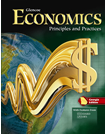Economics Principles and Practices © 2012 GeorgiaChapter 11:
Financial MarketsChapter OverviewsSection 1: Savings and the Financial System
People who save their money make it easier for businesses to spend, which in turn, produces economic growth. The role of saving in a financial system is the process that makes dollars available for others to invest. Financial assets—such as savings accounts, bonds, certificates of deposit (CDs), and many other types are issued by individuals, businesses, and governments. Another important group of financial intermediaries is called non-bank financial institutions—or non-depository institutions that also channel savings to borrowers. Finance companies, life insurance companies, and pension funds are examples of non-bank financial institutions. Finally, investors need to consider the following factors before investing their money: consistency, simplicity, risk-return relationship, and investment objectives. Section 2: Financial Assets and Their Markets
When people decide to invest their money, they have many options. Some main investments include CDs, bonds, bills, and IRAs, all of which vary in cost, maturity, and risk. Financial assets are grouped into different markets depending on their maturity and liquidity. Financial assets are grouped into four different markets: capital market, money market, primary market, and secondary market. Section 3: Investing in Equities and Options
Purchasing stocks is another form of investment. Equities, or stocks, are shares of common stocks that represent ownership of corporations. Many stocks are traded on organized exchanges like the NYSE Euronext and the many regional exchanges around the country. However, the great majority are traded on a computerized marketplace of organized dealers called an over-the-counter market. Investors follow the Dow-Jones Industrial Average (DJIA) or the Standard & Poor's 500 (S&P 500) to track the performance of stocks. Bull markets are strong markets with prices going up; bear markets are bad markets with prices going down. Investors who are not afraid of risk can also invest in futures and options if these suit their investment needs.
 | 






